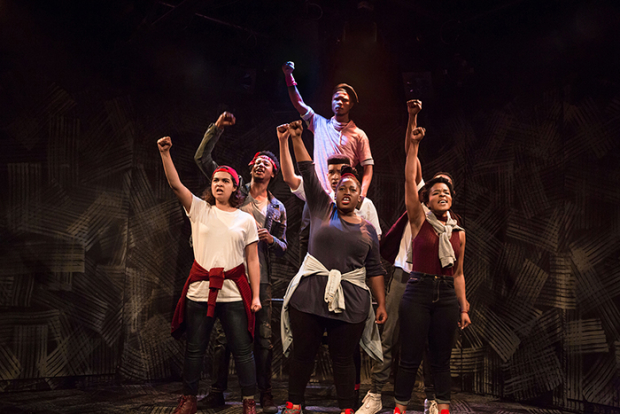
(© Oscar O'Ryan)
Apartheid in South Africa officially ended in 1994. Yet the issues that caused crises throughout the apartheid years — issues of race, power, class, and religious and gender discrimination — haunted South Africa for decades after segregation formally ended. In March 2017, however, students at South Africa's University of Cape Town demanded the removal of a statue of British imperialist Cecil Rhodes, a structure that was symbolic of white supremacy and its intolerant policies. The students' demand inspired the #RhodesMustFall movement, and thanks to them, the statue finally fell.
The Fall was written in response to the events that lasted from March to November 2017, beginning with an on-campus sit-in and ending with a sit-in in Parliament. It is told by a group of seven students who helped bring down the Rhodes statue. The cocreators and actors of The Fall — all people of color — were invited by South Africa's Baxter Theatre Center to create a record of a new generation of young people coming together to document their feelings about the possibilities for real freedom. Now, Studio Theatre is presenting a stunning Washington, DC, premiere of that record. The seven actors onstage are the students who cocreated and acted in the first production. They are joined by their original director, Clare Stopford.
The play begins as four men and three women stomp onstage, and form a circle, chanting loudly. Suddenly, their fortissimo chant drops to pianissimo and a single actor steps forward to speak, the chant continuing in the background. It is a musical structure that occurs repeatedly in the show, giving each individual a chance to tell his or her story, while the group continues to provide backup. The cocreators of The Fall have made it clear that the stories they tell are not their own personal histories, but that they belong to people just like them, people whose voices should be heard. Some of the tales are more harrowing than others. One slender young man who is studying to be a Health Services worker describes how he doesn't go to the cafeteria at mealtime because he can't afford the food there. Another young man, who is gay, primarily hopes that all students will eventually be free to love whomever they choose.
Ninety-nine percent of the impact of The Fall comes from the eruption and collision of animated dance, song, and verbal exchange that makes up the production. This is very much an ensemble show. The company is made up of extraordinarily skilled dancers, singers, and actors who bring a richness and power to the music, including Ameera Conrad, Oarabile Ditsele, Zandile-Izandi Madliwa,Tankiso Mamabolo, Sizwesandile Mnisi, Sihle Mnqwazana, and Cleo Raatus. Conrad and Thando Mangcu are its curators.
Scenic designer Patrick Curtis creates a black box playing space whose only props are three black tables. The actors use the full space, including the tabletops, to provide an alternative to a primarily horizontal presentation. A large screen on the rear wall projects video footage from Facebook. As the actors talk about police brutality, tasers, pepper spray, and stun guns, images of crowds being pushed and arrested by police are effectively projected. Costume designer Marisa Steenkamp dresses the actors in the uniform of every university student: jeans, sweaters, and T-shirts.
Documentary theater can often sound preachy. Political theater can often sound didactic. Neither happens in The Fall. Without making conclusions or judgments about the future, The Fall very simply offers vivid truths about a past that is too recent to ignore and too violent to forget.








